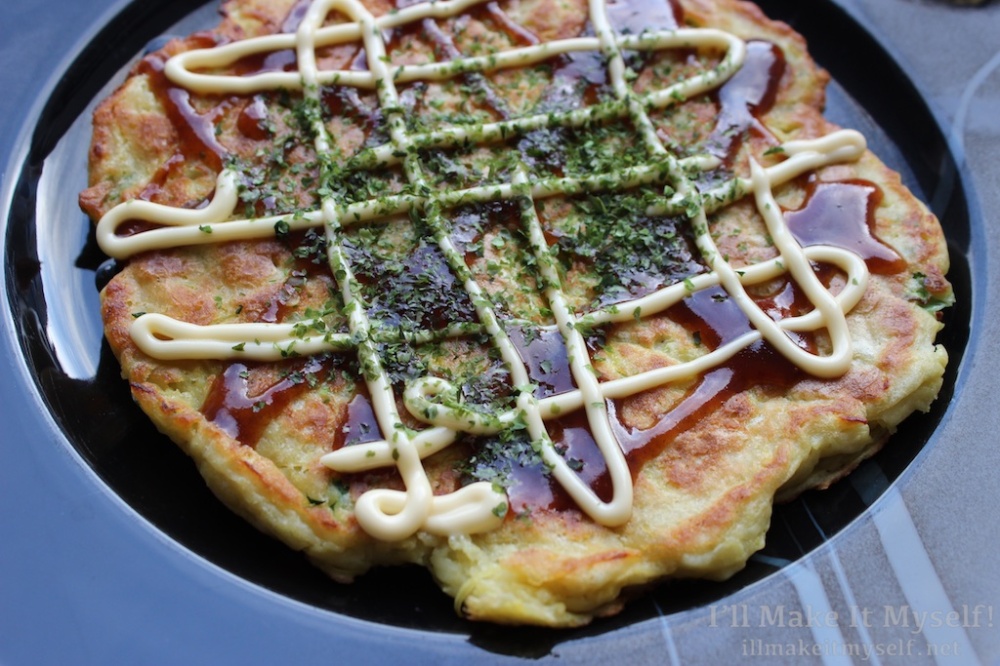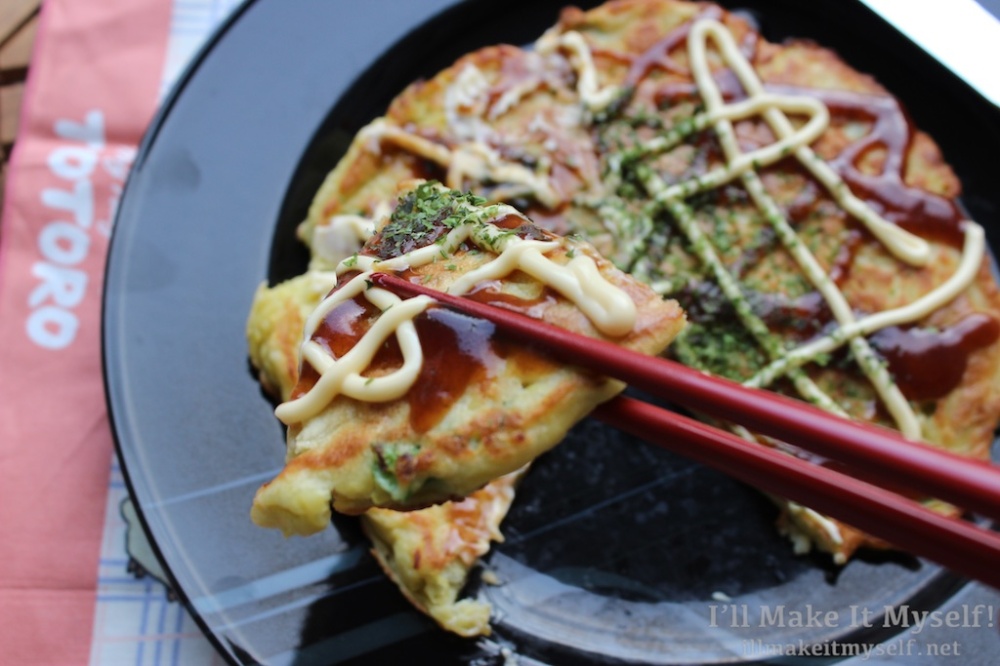Updated April 2, 2016.
While on my squash spree last month, I picked up a spaghetti squash, which has a great name in Japanese, too: soumen kabocha (そうめんかぼちゃ), like soumen noodles, or kinshiuri (金糸瓜), “golden thread squash.” This was my first time cooking this type of squash, and I had no idea what to do with it. First, I tried eating it like spaghetti and made a tomato sauce for it, but it came out like Italian-inspired coleslaw, which was pretty okay on lentil burgers.
My searches of all the blogs, cookbooks, and cooking sites I use didn’t turn up much in the way of other recipes that I felt like eating and I didn’t have the time to hit or budget the store for more ingredients. Maybe I’d use it in a “leftovers” food like stir-fry, or–great idea #1–okonomiyaki. Without any cabbage, which I rarely have in stock, I hit on great idea #2: forget the cabbage, the squash would be the vegetable base.

The great thing about using spaghetti squash in okonomiyaki is that the batter helps with the texture, making it easier to eat. Plus, the squash is a little more flavorful than cabbage, and it also pairs well with so many other ingredients that you can dress it up however you like. You could use okonomiyaki standards like mixed seafood, or flavors that pair well with squash like mushrooms and salmon; the squash also goes well with okonomiyaki sauce and mayonnaise. Finally, spaghetti squash is cheap (in Kanazawa): one 600-800-gram squash will cost you about 50-200 yen. (Cabbage is cheap, too, but you won’t break the bank trying to spice your dinner up a bit with this squash.)
If you cook the squash ahead of time, this meal can come together in about 15 minutes. I’ve included instructions for cooking the squash, the okonomiyaki, and for optional add-ins below. I use store-bought okonomiyaki flour, which contains some fish-based seasoning, but this recipe can be made from scratch to be completely vegetarian (or if you can’t buy okonomiyaki flour): see Just Hungry for batter recipes.

How to Cook Spaghetti Squash
I find boiling works best in my kitchen, but one may also use the oven or microwave. Reference: “How to Cook Spaghetti Squash” on food.com.
Boiling: 20-30 min.
1. Set a large pot of water to boil.
2. Rinse the squash and cut in half along the equator.
3. Boil squash for 20-30 minutes or until the skin can be pierced by a fork.
4. Remove squash and drain well. When cool enough to handle, scoop out seeds and pulp. Remove the strands of squash by using the tine of a fork to gently twist the squash off the skin. Set aside.
Oven: 60-90 min.
1. Rinse squash. Cut lengthwise and remove seeds.
2. Place in a roasting pan with about 2 cm of water.
2. Cook at 190°C (375°F) for 1 – 1.5 hours or until the skin is easily pierced by a fork.
4. Remove squash and drain well. When cool enough to handle, scoop out seeds and pulp. Remove the strands of squash by using the tine of a fork to gently twist the squash off the skin. Set aside.
Microwave: 20 min.
1. Rinse squash. Cut lengthwise and remove seeds.
2. Place in a roasting pan with about 2 cm of water.
3. Cover in plastic wrap and cook on high for 10-12 minutes.
4. Let stand for 5 minutes before removing plastic wrap.
5. Remove squash and drain well. When cool enough to handle, scoop out seeds and pulp. Remove the strands of squash by using the tine of a fork to gently twist the squash off the skin. Set aside.
Leftover cooked squash will keep in the refrigerator for 3-5 days or in the freezer for 10-12 months.
Spaghetti-Squash Okonomiyaki
Makes 2 okonomiyaki
Ingredients
100 g (3.5 oz) okonomiyaki flour (okonomiyakiko, お好み焼き粉)
200 g (7 oz) spaghetti squash, cooked (soumen kabocha, そうめんかぼちゃ; or kinshiuri, 金糸瓜)
1 egg (tamago, 卵)
1/2 stalk of green onions or to taste (negi, ネギ)
100 mL (1/3 cup + 1 TBSP) water
Other add-ins (see below)
~1 Tablespoon sesame oil (for cooking) (goma abura, ごま油)
Condiments
~2 Tablespoons okonomi sauce (okonomi sôsu, お好みソース)(1 per okonomiyaki)*
~2 teaspoons Japanese mayonnaise(mayonêzu, マヨネーズ) (1 per okonomiyaki)**
A sprinkle of nori (dried seaweed)(aonori, 青のり)
Katsuobushi (dried bonito flakes), to taste(katsuobushi, カツオブシ, 鰹節)
Equipment
1 large frying pan
2 spatulas
Procedure
1. Dice the cooked squash into small pieces–this will make the okonomiyaki easier to eat and less stringy. Dice green onions and any other add-ins as appropriate.
2. Combine flour, squash, egg. onion, other add-ins, and water. Stir well to combine.
3. Heat a little sesame oil in the frying pan. When hot, add half of the batter and spread into a pancake shape.
4. When the sides firm up and the bottom browns a little, use spatulas to flip the okonomiyaki. Cook other side until the pancake is cooked through.
5. Remove okonomiyaki to plate. Repeat for second okonomiyaki.
6. Garnish with okonomi sauce, mayonnaise, nori, and/or bonito flakes. Serve hot.
Suggested Add-ins
This okonomiyaki is fine as-is, but you can add other vegetables, mushrooms, and meat to it to use up leftovers or make it more interesting.
Note: If using meat, I like to cook mine, dice it, and mix it in with the batter for this recipe. You can cook yours in the same pan immediately before cooking the okonomiyaki or use leftovers.
1 trumpet mushroom, diced (eringi, エリンギ)
a handful of maitake mushrooms, diced (マイタケ、舞茸)
100 g (3.5 oz) salmon, flaked (shake, sake, 鮭)
50 g (1.5 oz) ham, diced (I use leftover coldcuts) (hamu, ハム)
1 Tbsp pickled ginger, minced (beni shôga, 紅ショウガ)
30 g (1 oz) shredded cheese (nachuraru chîzu, ナチュラルチーズ)
If you come up with any favorite add-ins for this dish, please comment!
Nutritional Information
Serving size: 1 pancake. 285 calories. Nutritional information is for just the okonomiyaki, sauces, and bonito flakes with no additional add-ins.
I normally use Calorie Counter, but I couldn’t because of the Japan-specific ingredients, so I used EiyouKeisan.com and the sauce websites (below) to get the calorie information.
Notes
*I like Otafuku brand (オタフク).
**Most people use Kewpie (キューピー); I prefer Pure Select Super Low Calorie, Calorie 70% Cut (ピュアセレクト® スーパーローカロリーカロリー70%カット) (the one with a green cap) because it is lower in calories and has a longer shelf life. I almost never use mayonnaise, so it takes me forever to get through a bottle.
I have a favorite spaghetti squash casserole recipe I always make from The Moosewood Cookbook. It’s really good! Baking it in the oven takes between 30~45 minutes depending on the size. I’ll have to try it in okonomiyaki one of these days! Unfortunately, I didn’t grow my own this year! I usually have so many that I end up feeding them to the chickens over the winter.
I have heard good things about Moosewood! I was surprised that Bittman’s How to Cook Everything Vegetarian yielded nothing–surely spaghetti squash is part of “everything.” ;) Is it this one? http://www.recipesource.com/main-dishes/casseroles/spaghetti-squash-lentils1.html
Yes, that’s it. The lentils threw me off a bit, but I see that it’s a variation. Moosewood has so many good recipes! I love it! I’m in the process of harvesting my honey. I will be going to Kanazawa later in the month (probably the weekend of the 20th/21st). Let me know if you’re still interested is trying it.
Definitely–I just emailed you!
My boss gave me two of these last week. Once I’m back from vacation, this will definitely be on the menu.
Yay! It’s so easy. Safety travels and enjoy the food on vacation!
The only way I’ve ever cooked spaghetti squash has been to mix it with butter and cheese and bake it as a casserole. But your okonomiyaki sounds like a healthier way to use it.
I haven’t had a lot of luck finding recipes either, so I want to experiment more with it. Let me know if you try the okonomiyaki!
To cook spaghetti squash, I poke a few holes in it, then put it whole on a plate in the microwave. Cook for 3 minutes, rotate 1/4 turn, 3 more minutes, continue. It’ll be done in 12 – 18 minutes, depending on size of the squash.